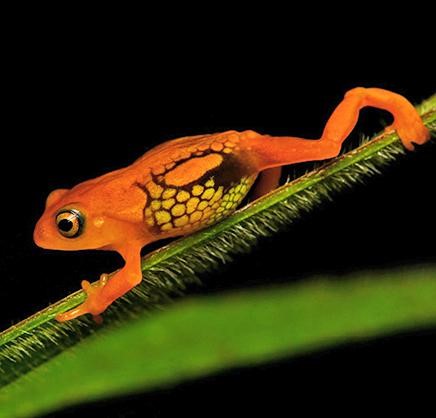Description

Source:
Hindu
Disclaimer: Copyright infringement not intended.
Context
- The Monsoon Croaks Bioblitz 2024 is a citizen science initiative organized by the Centre for Citizen Science and Biodiversity Informatics under the Kerala Forest Research Institute (KFRI).
- This project aims to document the frog species in Kerala, India, during the monsoon season, highlighting the importance of frogs as indicators of ecosystem health.
Details
Project Goals
- Documentation:To record the presence and diversity of frog species across various habitats in Kerala.
- Public Participation:Encourage people of all ages to engage in scientific documentation.
- Awareness and Conservation:Use the collected data to promote biodiversity awareness and inform conservation strategies.
Importance of Frogs
- Ecosystem Indicators:Frogs are sensitive to environmental changes, making them valuable indicators of ecosystem health.
- Threats:Climate change, habitat loss, pollution, and altered rainfall patterns are significant threats to frog populations.
- Conservation Status:Approximately 41% of frog species worldwide are listed as endangered by the IUCN. Kerala, with over 200 frog species, faces similar conservation challenges.
Key Activities
- Bioblitz:An intensive survey aimed at identifying as many frog species as possible within a designated area and time frame.
- Habitats:Frogs are documented not only in forests but also in farms, gardens, and backyards.
- Public Involvement:Citizens contribute to the scientific community by sharing observations and data through the iNaturalist platform.
Benefits of the Project
- Scientific Contribution:Enhances the understanding of frog distribution and diversity in Kerala.
- Conservation Efforts:Helps in identifying key habitats and formulating conservation strategies.
- Climate Change Research:Provides data for studying the impacts of climate change on amphibian populations.
- Policy Making:Informs environmental policies and conservation priorities based on scientific data.
About Frogs
Taxonomy and Classification
- Kingdom:Animalia
- Phylum:Chordata
- Class:Amphibia
- Order:Anura
- Families:Includes over 50 families, such as Ranidae (true frogs), Hylidae (tree frogs), Bufonidae (toads), and Dendrobatidae (poison dart frogs).
Physical Description
- Size:Varies widely; smallest species like Paedophryne amauensis are about 7.7 mm, while the largest, Conraua goliath, can be up to 32 cm (12.6 inches).
- Body Structure:Short-bodied, broad-headed with protruding eyes, and long hind legs adapted for leaping.
- Skin:Smooth or warty, often moist due to mucus secretion; coloration ranges from dull browns and greens to bright, vivid patterns for camouflage or warning.
Distribution and Habitat
- Global Range:Found on every continent except Antarctica.
- Habitat:Diverse, including tropical rainforests, temperate forests, deserts, savannas, freshwater bodies (ponds, lakes, rivers), and even urban areas.
- Altitude Range:From sea level to high mountain regions.
Life Cycle and Reproduction
- Egg Stage:Typically laid in water; some species lay eggs in moist terrestrial environments.
- Larval Stage (Tadpoles):Aquatic, with gills for respiration and a diet primarily consisting of algae and plant matter.
- Metamorphosis:Transformation from tadpole to adult frog involves development of lungs, limbs, and the absorption of the tail.
- Adult Stage:Primarily carnivorous, feeding on insects, small invertebrates, and occasionally small vertebrates.
Behavior and Ecology
- Diet:Carnivorous as adults; diet includes insects, spiders, worms, and small vertebrates. Some tadpoles are herbivorous or omnivorous.
- Predation:Predators include birds, mammals, reptiles, fish, and other amphibians.
- Defense Mechanisms:Camouflage, toxic skin secretions, and startling displays (e.g., sudden leaps or revealing bright colors).
Vocalizations
- Purpose:Mating calls, territorial calls, distress calls.
- Sound Production:Vocal sacs amplify sound; calls can range from croaks and ribbits to whistles and trills.
- Communication:Important for mating and establishing territories.
Adaptations
- Camouflage:Blending with surroundings to avoid predators.
- Toxins:Many species produce skin toxins as a defense mechanism.
- Breathing:Can respire through lungs, skin, and the lining of the mouth.
- Jumping Ability:Powerful hind legs adapted for leaping.
Conservation Status
- IUCN Red List:Various statuses; some species are Least Concern, while others are Critically Endangered.
- Threats:Habitat destruction, climate change, pollution, disease (e.g., chytridiomycosis), invasive species, over-exploitation.
- Conservation Efforts:Habitat protection, captive breeding programs, disease management, and environmental regulations.
Interesting Facts
- Diverse Reproduction Strategies:Some frogs exhibit unique reproductive behaviors, such as carrying eggs on their backs or in their mouths.
- Antifreeze-like Substances:Certain species produce glycerol or glucose to survive freezing temperatures.
- Regenerative Abilities:Some frogs can regenerate lost limbs, though not as efficiently as salamanders.
- Indicator Species:Frogs are often used as bioindicators due to their sensitivity to environmental changes.
Notable Species
- Common Frog (Rana temporaria):Widespread in Europe.
- American Bullfrog (Lithobates catesbeianus):Native to North America, known for its deep call.
- Poison Dart Frog (Dendrobatidae):Small, brightly colored frogs from Central and South America, known for their potent toxins.
- Goliath Frog (Conraua goliath):Largest frog species, found in West Africa.
Sources:
Hindu
|
PRACTICE QUESTION
Q. Consider the following statements regarding frogs:
- Frogs are amphibians belonging to the order Anura.
- Frogs undergo complete metamorphosis, starting as tadpoles and developing into adults.
- Frogs respire through lungs throughout their life cycle.
Which of the statements given above is/are correct?
Options:
A. 1 only
B. 1 and 2 only
C. 2 and 3 only
D. 1, 2, and 3
Answer: B
|
















